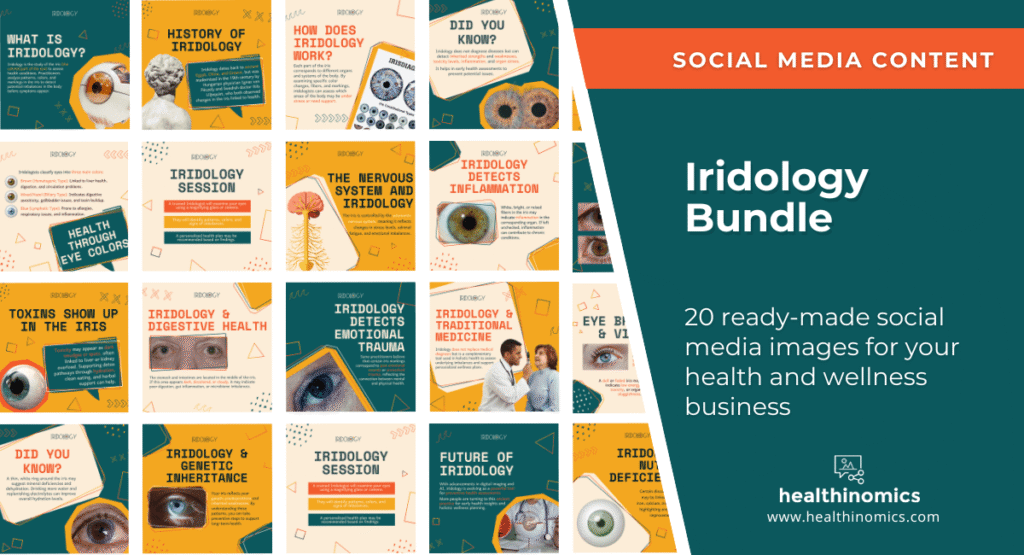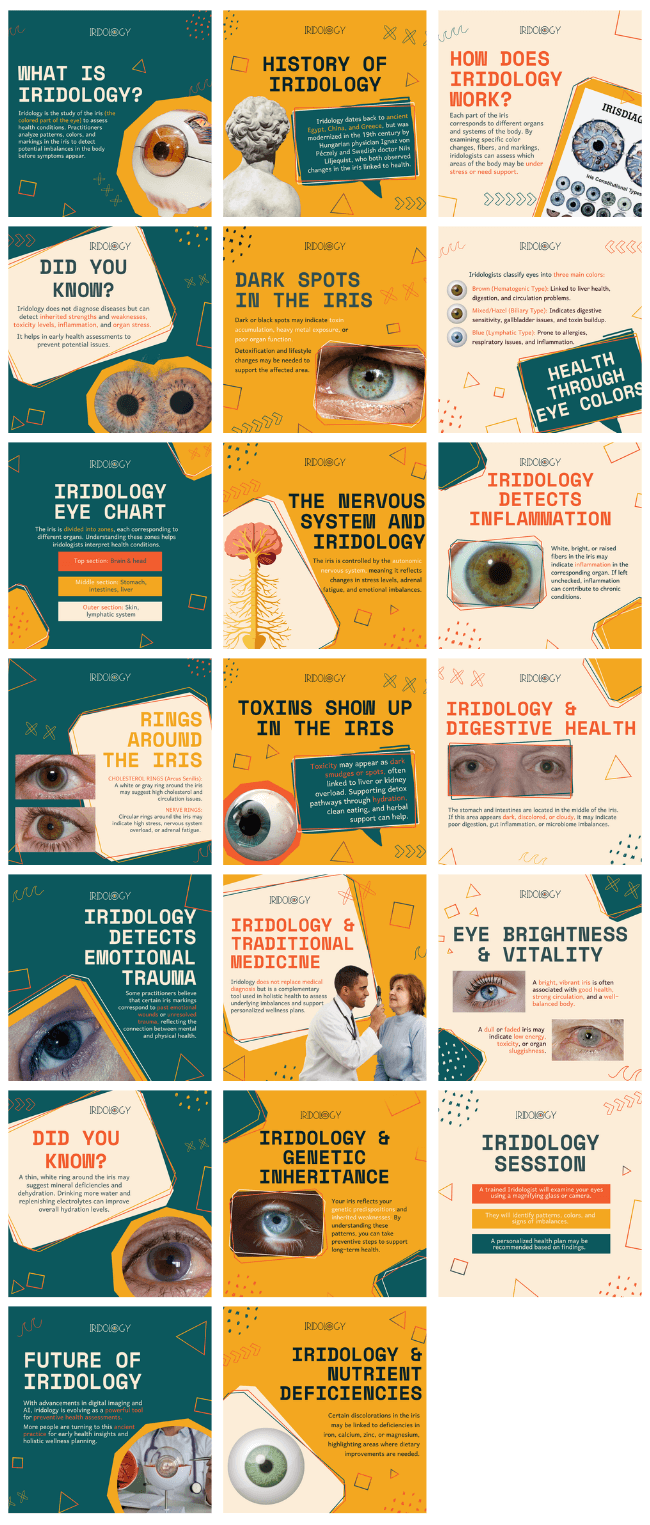The Iridology Social Media Bundle offers a clear introduction to iridology, a holistic practice that examines the patterns, colors, and signs in the iris to assess overall health.
Sharing this bundle on social media is important because it helps people better understand their bodies and encourages them to take a proactive role in their wellness. Educational posts like these can empower your followers to recognize early signs of imbalance and seek appropriate care before issues worsen.
By sharing iridology tips and insights, you create a space where your community feels informed and supported, motivating them to make healthier choices. This kind of meaningful content not only educates but also builds a positive, engaged community focused on holistic well-being.
Inside The Social Media Bundle
BONUS 20 sample captions for you to share with your bundle!
BONUS Editable Canva Template!
The Iridology social media bundle includes 20 beautiful pieces of visual content ready to share:

Social Media Image Content Ready to Share:
1. What is Iridology?
Iridology is the study of the iris (the colored part of the eye) to assess health conditions. Practitioners analyze patterns, colors, and markings in the iris to detect potential imbalances in the body before symptoms appear.
2. The History of Iridology
Iridology dates back to ancient Egypt, China, and Greece, but was modernized in the 19th century by Hungarian physician Ignaz von Péczely and Swedish doctor Nils Liljequist, who both observed changes in the iris linked to health.
3. How Does Iridology Work?
Each part of the iris corresponds to different organs and systems of the body. By examining specific color changes, fibers, and markings, iridologists can assess which areas of the body may be under stress or need support.
4. Did You Know?
Iridology does not diagnose diseases but can detect inherited strengths and weaknesses, toxicity levels, inflammation, and organ stress. It helps in early health assessments to prevent potential issues.
5. Dark Spots in the Iris
Dark or black spots may indicate toxin accumulation, heavy metal exposure, or poor organ function. Detoxification and lifestyle changes may be needed to support the affected area.
6. Health Through Eye Colors
Iridologists classify eyes into three main colors:
- Blue (Lymphatic Type): Prone to allergies, respiratory issues, and inflammation.
- Brown (Hematogenic Type): Linked to liver health, digestion, and circulation problems.
- Mixed/Hazel (Biliary Type): Indicates digestive sensitivity, gallbladder issues, and toxin buildup.
7. Iridology Eye Chart
The iris is divided into zones, each corresponding to different organs. Understanding these zones helps iridologists interpret health conditions.
- Top section: Brain & head
- Middle section: Stomach, intestines, liver
- Outer section: Skin, lymphatic system
8. The Nervous System and Iridology
The iris is controlled by the autonomic nervous system, meaning it reflects changes in stress levels, adrenal fatigue, and emotional imbalances.
9. Iridology Detects Inflammation
White, bright, or raised fibers in the iris may indicate inflammation in the corresponding organ. If left unchecked, inflammation can contribute to chronic conditions.
10. Rings Around the Iris
- Cholesterol Ring (Arcus Senilis): A white or gray ring around the iris may suggest high cholesterol and circulation issues.
- Nerve Rings: Circular rings around the iris may indicate high stress, nervous system overload, or adrenal fatigue.
11. Toxins Show Up in the Iris
Toxicity may appear as dark smudges or spots, often linked to liver or kidney overload. Supporting detox pathways through hydration, clean eating, and herbal support can help.
12. Iridology & Digestive Health
The stomach and intestines are located in the middle of the Iris. If this area appears dark, discolored, or cloudy, it may indicate poor digestion, gut inflammation, or microbiome imbalances.
13. Iridology Detects Emotional Trauma
Some practitioners believe that certain iris markings correspond to past emotional wounds or unresolved trauma, reflecting the connection between mental and physical health.
13. Iridology & Traditional Medicine
Iridology does not replace medical diagnosis but is a complementary tool used in holistic health to assess underlying imbalances and support personalized wellness plans.
15. Eye Brightness & Vitality
A bright, vibrant iris is often associated with good health, strong circulation, and a well-balanced body, while a dull or faded iris may indicate low energy, toxicity, or organ sluggishness.
16. Did You Know?
A thin, white ring around the iris may suggest mineral deficiencies and dehydration. Drinking more water and replenishing electrolytes can improve overall hydration levels.
17. Iridology & Genetic Inheritance
Your iris reflects your genetic predispositions and inherited weaknesses. By understanding these patterns, you can take preventive steps to support long-term health.
18. How It Shows Nutrient Deficiencies
Certain discolorations in the iris may be linked to deficiencies in iron, calcium, zinc, or magnesium, highlighting areas where dietary improvements are needed.
19. Iridology Session
- A trained iridologist will examine your eyes using a magnifying glass or camera.
- They will identify patterns, colors, and signs of imbalances.
- A personalized health plan may be recommended based on findings.
20. The Future of Iridology
With advancements in digital imaging and AI, iridology is evolving as a powerful tool for preventive health assessments. More people are turning to this ancient practice for early health insights and holistic wellness planning.


